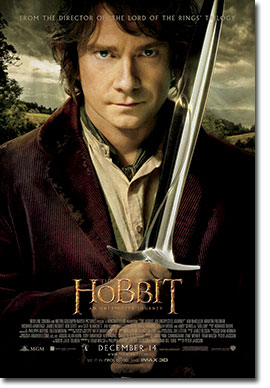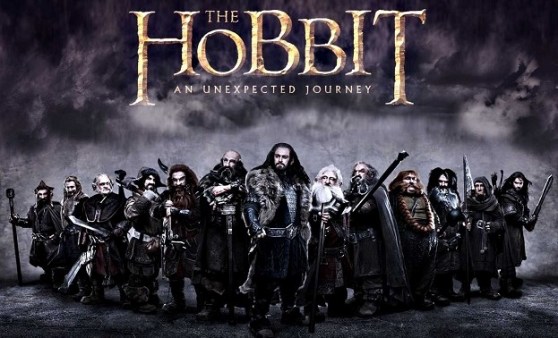THE HOBBIT: AN UNEXPECTED JOURNEY, the first of a trilogy of films adapting the enduringly popular masterpiece “The Hobbit”, by J.R.R. Tolkien will open in theaters nationwide on December 14.
The three films tell a continuous story set in Middle-earth 60 years before “The Lord of the Rings,” which Academy Award-winning filmmaker Peter Jackson and his filmmaking team brought to the big screen in the blockbuster trilogy that culminated with the Oscar®-winning “The Lord of the Rings: The Return of the King.” Ian McKellen returns as Gandalf the Grey, the character he played in “The Lord of the Rings” Trilogy, with Martin Freeman in the central role of Bilbo Baggins, and Richard Armitage as Thorin Oakenshield. Also reprising their roles from “The Lord of the Rings” in “The Hobbit” Trilogy are: Cate Blanchett as Galadriel; Ian Holm as Old Bilbo; Christopher Lee as Saruman; Hugo Weaving as Elrond; Elijah Wood as Frodo; and Andy Serkis as Gollum.
The story follows the journey of Bilbo Baggins who becomes involved in a quest to reclaim the lost Dwarf Kingdom of Erebor from the Dragon Smaug. Gandalf the Grey approaches Bilbo and soon Bilbo finds himself journeying alongside 13 dwarves led by Thorin Oakenshield, a legendary warrior. Their journey will take them into wild lands swarming with goblins, orgs, and wargs, as well as a mysterious and evil figure known as the Necromancer. Under Peter Jackson, The Hobbit was shot in 3D 48 FPS (frames-per-second) and is being released in High Frame Rate 3D (HFR 3D), IMAX, and other 2D and 3D formats.
The Hobbit is the first part of J.R.R. Tolkien’s epic saga that continues into The Lord of the Rings. This makes it a prequel to The Lord of the Rings trilogy. The Hobbit: An Unexpected Journey has been adapted from the book, The Hobbit, which has sold more than 100 million copies and translated into 50 languages. It has never been out of print in 75 years. The Lord of the Rings made a successful translation into film where they have become ingrained into cultural lexicon. Each film received critical acclaim and awards. The final film of the epic trilogy, The Lord of the Rings: The Return of the King, won 11 Oscars including Best Picture, Best Director, and Best Screenplay. Quite a big accomplishment if you ask me!
So far, reaction to this movie from people who were lucky enough to attend the premiere has been described as “beautiful” and “awesome”. Thousands of people lined up in Wellington, New Zealand where the stars came out also for the chance to see the movie. However, in the Las Vegas premiere, The Hobbit had a bit of a mixed reaction in regards to the 48 FPS effect. In an article from the Telegraph, some people said that the film rate of 48 FPS makes movement feel more accurate as well as being gentle on the eyes. However, one person speaking to Variety compared it to viewing Blu-Ray for the first time. A consensus among journalists called the effect cheap. Jim Vejvoda of IGN Movies likened it to watching a soap opera because while it looks like live TV or an HD video, the 48 FPS didn’t look particularly good and it showed when the good guys were facing off against CG-created characters or quickly moving down a rocky passage. The camera pan and the blur was a turn off to him. Still, others who liked the 48 FPS effect said that people need to get used to the effects. The reel was “distinctively sharper and immediate than any other film seen previously during the evening”, although the human actors were “overlit and amplified”. Another blow is that only a few cinemas possess the required projectors to view The Hobbit in its 48 FPS glory, so while us regular people may not have to worry about those expectations, unless we find a theater that has that kind of equipment, we might not be seeing it as it was intended, which may be an annoyance for some people. The content though was the same as it was in Wellington’s premiere: Positive, especially with the mountain scenes and CGI magic. Judging from the reaction though, the 48 FPS effect needs some fine-tuning before cinemas start using that technology. The Telegraph concludes the article saying that directors and producers are likely to be wary of shooting with 48 FPS for now and that the heralding of this new filming technique was not as good as was hoped. It’s still a good movie though, which needs to be judged on content, so it’s a recommended viewing, especially to those who have seen the Lord of the Rings trilogy.
Here is the trailer: http://www.youtube.com/watch?v=ZEOM13UyZ0A
Follow us at https://www.facebook.com/AsianInNYFans for more future events.




Leave a Reply